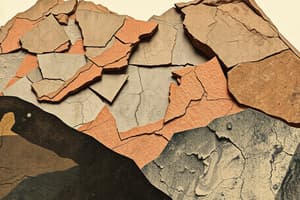Podcast
Questions and Answers
Under what conditions do metamorphic rocks form?
Under what conditions do metamorphic rocks form?
Heat and pressure deep beneath Earth's surface.
How do geologists classify metamorphic rocks?
How do geologists classify metamorphic rocks?
By the arrangements of the grains that make up the rocks: foliated and nonfoliated.
How are metamorphic rocks used?
How are metamorphic rocks used?
As building materials and for sculptures.
Two of the most useful metamorphic rocks are:
Two of the most useful metamorphic rocks are:
The word metamorphic comes from the Greek words ___ and ___.
The word metamorphic comes from the Greek words ___ and ___.
What rocks can metamorphic rocks form out of?
What rocks can metamorphic rocks form out of?
Geologists classify metamorphic rocks according to:
Geologists classify metamorphic rocks according to:
Metamorphic rocks that have their grains arranged in parallel layers are said to be ___.
Metamorphic rocks that have their grains arranged in parallel layers are said to be ___.
The term foliated comes from the Latin word for:
The term foliated comes from the Latin word for:
Some metamorphic rocks are ___. The mineral grains in these rocks are arranged randomly.
Some metamorphic rocks are ___. The mineral grains in these rocks are arranged randomly.
Metamorphic rocks that are nonfoliated do not split into layers.
Metamorphic rocks that are nonfoliated do not split into layers.
Marble is a:
Marble is a:
Shale (sedimentary) heat and pressure =
Shale (sedimentary) heat and pressure =
What does metamorphic mean?
What does metamorphic mean?
Where and under what conditions are metamorphic rocks formed?
Where and under what conditions are metamorphic rocks formed?
What characteristic of metamorphic rocks do geologists use to classify them?
What characteristic of metamorphic rocks do geologists use to classify them?
How does a foliated metamorphic rock form?
How does a foliated metamorphic rock form?
What are the main uses of metamorphic rocks?
What are the main uses of metamorphic rocks?
Two forces that can change rocks into metamorphic rocks are:
Two forces that can change rocks into metamorphic rocks are:
How are metamorphic rocks formed?
How are metamorphic rocks formed?
List the 2 forces that can change a rock into a metamorphic rock.
List the 2 forces that can change a rock into a metamorphic rock.
Metamorphic rocks form deep beneath Earth's surface.
Metamorphic rocks form deep beneath Earth's surface.
What rocks can be changed into metamorphic rocks?
What rocks can be changed into metamorphic rocks?
The deeper a rock is buried in the crust, the less pressure there is on it.
The deeper a rock is buried in the crust, the less pressure there is on it.
Metamorphic rocks with grains arranged in parallel layers or bands are said to be what?
Metamorphic rocks with grains arranged in parallel layers or bands are said to be what?
What is the color of slate?
What is the color of slate?
Geologists classify metamorphic rocks by the arrangement of grains making up the rock.
Geologists classify metamorphic rocks by the arrangement of grains making up the rock.
Flashcards are hidden until you start studying
Study Notes
Formation of Metamorphic Rocks
- Metamorphic rocks form from existing rocks under heat and pressure deep beneath Earth's surface.
- Any rock type, including igneous or sedimentary, can be transformed into metamorphic rock.
Classification of Metamorphic Rocks
- Geologists classify metamorphic rocks based on the arrangement of mineral grains.
- Two main categories exist: foliated and nonfoliated.
- Foliated rocks have grains arranged in parallel layers, while nonfoliated rocks do not show layering.
Terminology
- "Metamorphic" originates from Greek, where "meta" means "change" and "morphosis" means "form."
- "Foliated" derives from Latin, meaning "leaf," referring to the thin, flat layers in certain metamorphic rocks.
Key Examples of Metamorphic Rocks
- Common foliated metamorphic rocks include slate, schist, and gneiss.
- Notable nonfoliated metamorphic rocks are marble and quartzite.
- Slate forms from the metamorphism of shale under heat and pressure.
Uses of Metamorphic Rocks
- Metamorphic rocks are valuable for construction and sculpture.
- Marble is often used in art and architectural designs due to its aesthetic appearance.
Properties of Metamorphic Rocks
- Nonfoliated metamorphic rocks do not split into layers, unlike foliated types.
- The color of slate is typically gray.
Conditions of Metamorphism
- Intense heat and pressure are the primary forces that drive the metamorphism of rocks.
- The deeper the rock is buried in the crust, the greater the pressure exerted on it.
Statements on Metamorphic Rock Formation
- It is true that metamorphic rocks form under deep conditions with high heat and pressure.
- The statement that "the deeper a rock is buried, the less pressure there is" is false.
True/False Statements
- True: Geologists classify metamorphic rocks by the arrangement of their mineral grains.
- True: Metamorphic rocks predominantly form deep within the Earth's crust.
Studying That Suits You
Use AI to generate personalized quizzes and flashcards to suit your learning preferences.




